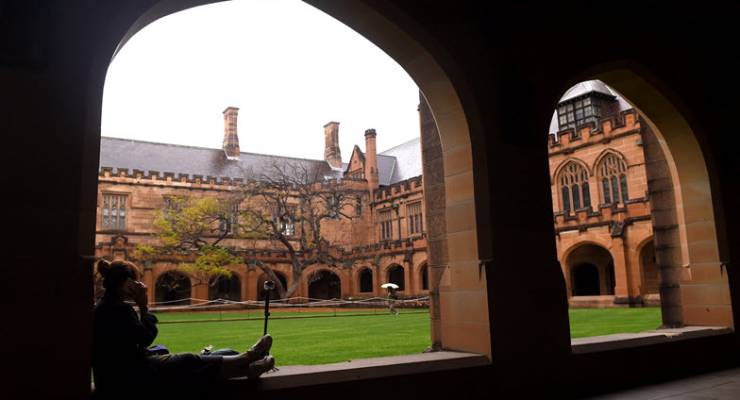
Australia’s universities, over-reliant for the past decade on billions of dollars in tuition fees from Chinese students, are anxiously awaiting the arrival of students ahead of their so-called census dates. Will there be financial fallout from the accelerating Wuhan coronavirus?
The stakes are very high: the Australian international education market was worth $35.2 billion in 2018-2019.
The census date is the date after which students are liable to start paying fees, when their grades will be recorded and the course will remain on their transcripts. If students withdraw before this, they are not liable to pay any fees, no grades are recorded and the course is removed from their transcripts.
Students are also entitled to get any deposits back if they withdraw before census date; most universities require one term’s worth of fees from international students.
Census dates vary by institution and course, but are usually around March 31 for domestic students. For international students, the date is often the start date of the course.
Tertiary education industry insiders said that the sector has been closely watching the situation in China since institutions were advised of potential pandemic from the Wuhan coronavirus in early January.
Many universities have been working overtime to upgrade digital assets so students unable to make it to Australia by the start of term can learn remotely. Most have also been working up offers that make it easier for students to defer study without any costs.
It’s important to note the $35.2 billion valuation includes not just tuition, but all other money spent by students including rent, study materials and general consumption.
The largest slice of this by some way comes from Chinese students. Around 25% of all students at Australian universities pay international fees and about 40% of those students are Chinese. This means that about 10% of all students in Australian universities are from China.
Roughly 164,000 Chinese students attend university in Australia, along with another 40,000 or so in other educational institutions including schools. That represents a total value of about $15 billion a year to the Australian economy (Chinese students on average enrol in more expensive courses than students from other countries).
The university sector has been scrambling to diversify amid warnings last year that the Chinese student boom has peaked. A report by the Centre for Independent Studies (CIS) last August identified seven universities with “extraordinary levels” of exposure to the Chinese market: the University of Melbourne, Australian National University (ANU), University of Sydney, University of New South Wales (UNSW), University of Technology Sydney (UTS), University of Adelaide and University of Queensland (UQ).
“At all seven, Chinese students seem to account for more than 50% of all international students,” the report said. “In 2017, they relied on Chinese student course fees for anywhere from 13% (Adelaide and ANU) to 22-23% (UNSW and Sydney) of their total revenues.”
Even these figures likely understate their true exposure, since they generate substantial non-course revenue from Chinese students as well. International comparisons reveal the excessiveness of this China exposure, the report added.
The report noted: “All seven have higher proportions of international and Chinese students than any university in the entire United States.”
The sector’s fears of substantial impact from the Wuhan coronavirus were writ large when Education Minister Dan Tehan recently added the effects of the virus to the government’s Global Reputation Taskforce (the taskforce was set up to deal with the economic fallout to international education from bushfires). The virus has also been confirmed in the sector’s number three and number five markets, Nepal and Malaysia.
This is affecting other sectors too. The rapidly spreading Wuhan coronavirus is shaping up as a similar shock for tourism, mining, agriculture, seafood, agribusiness and gambling.
As of last night, the virus has claimed 106 lives and official infections had topped 4000. But credible estimates by three medical research groups at universities in the United States, United Kingdom and Hong Kong released at the weekend estimate the real number of infected people to be somewhere between 44,000–190,000. The Chinese government has said infection rates are accelerating.
The overall economic impact for China is impossible to forecast except to say that, in the words of Dan Harris from the well-regarded China Law Blog, it will be disastrous.
“We are hearing reports of massive layoffs and furloughs without pay. All of this is going to be disastrous for China’s economy, which was in bad shape before the coronavirus hit,” Harris wrote.
As belts tighten in China, demand for Australia’s good and services weakens. The Chinese economy is also intertwined with every economy in the world, especially Asian nations who largely constitute Australia’s next biggest trading partners.








As usual Michael, you are missing the major aspects of the overseas student cash crop. It ought to be kept in mind that Dawkins (a minister for Hawke) changed the game of university finding to a long term untenable system.
About six or eight years ago an overseas qualification (e.g. a BCom) effected about a 50% difference (increase) in salary compared to a domestic qualification. Nowadays, the monthly difference would be 1,000 RMB if that. The attractiveness of overseas quals for Asia in general has been on the decline for three or four years. It is no longer financially justifiable; the only benefits are the overseas experience and making some life-long friends.
The market for the overseas Asian student was never going to last and it would be as well to plan for alternatives now. As for the current event consider the Spanish flu epidemic of 1919-20. The current event proxies for an exercise in crowd control. As for face marks the size of the virus is in the order of 150nm thus rendering face masks useless!
For what it is worth I taught a number of A-Level (matriculation) subjects to British [Oxbridge] and Ivy League universities for almost a decade in China.
An excellent summary Michael, capturing all the significant points. The longer, drawn out downturn was always expected and although substantial in its own right could have been managed, with some difficulty admittedly.
The short, sharp, shock, as per Pink Floyd’s phrase, is the larger danger locally. Layoffs of admin, then academic staff would filter through in a big employment sector quite quickly and then into the rental markets locally, the food and beverage and other services sectors where the multiplier is quite strong. The corollary effects on the Oz economy would be measurable. I’m betting there are a few universities more than a little concerned.
Frydenberg and Morrison would be too, if they had sufficient grey matter.
Add this to reduced markets and trade where we are mightily exposed, who isn’t, and it could finally be the reality check that brings down the lighter than air sharemarkets, currently held aloft by absurd policy and sheer luck.
The domestic financial implications are anything but clear except for the value of the commodity. A good percentage of junior lecturing staff are on contracts that are worded in favour of the teaching institution in question. Such has been the case for some decades.
As to a wider perspective there is the experience of SARS that can be used as a guide. In any event the disposition towards ‘sensationalism’ ought to be avoided.
“Many universities have been working overtime to upgrade digital assets so students unable to make it to Australia by the start of term can learn remotely.”
Ah well, numbers of those same students have, reportedly, been using “digital assets” to submit their assignments and theses anyway, so does it really matter?
I wonder what Thomas Malthus would say about these unsustainable practices of the universities….
As a former tenured and now sessional lecturer in Business Faculties at various Unis, all well outside the Group of 8, I can’t help feeling that it is fortunate that China is the country impacted. As the value of an Australian degree declines in China only the prestige universities continue to attract Chinese students in large numbers.
An epidemic centred in India would have a more widespread impact and deeper financial impact because the tertiary institutions dominated by students from India, Pakistan and Sri Lanka are much less able to ride out a temporary dip in overseas student numbers. The Group of 8 will suffer but their pockets are much deeper and their status means that Chinese students will probably return when the crisis is over. Not necessarily true for third tier Unis, whose overseas students just want a qualification and if they find it in a other country – almost inevitably closer to home – may make the switch permanent.
Although it’s my livelihood and therefore my self-interest, it has been clear to me for a decade that many – possibly most – students don’t learn much from their degrees and promoting a 40% target for degree qualified workers in Australia is more about reducing unemployment than offering education. Not a sustainable business model.